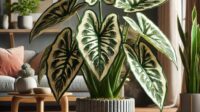
This type of Alocasia plant is a very special and interesting one that has won the hearts of many cultivators. This unusual houseplant, with its unique, stingray-shaped leaves looks both elegant and whimsical at the same time. Its long, tassle-like tails and thick green leaves means this is always a plant that gains top spot in any indoor foliage fix. An ideal choice for these after unique and unusual plant varieties, the Alocasia Stingray will genuinely draw your eye in! Its not only a fantastic talking point but also something super quirky to have within home. We will be covering everything you need to know about these unique plants in this guide, from their care information all the way up to how they started becoming a personification of collectors.
1. What Is Alocasia Stingray?
Alocasia Stingray is a tropical perennial plant native to Southeast Asia. The leaf of the Stingray peperomia is unique in that it actually resembles a Ray with round paddle-shaped foliage and long narrow tips mimicking a ray’s tail. Extremely variable and sought after by collectors as it has an exotic look with a nice compact growth.
2. Alocasia Stingray: Full Plant Detail (All About Learning)
Unique Look:Different from other Alocasia variety with its stunning stingray-shaped leaves.
– Small Space: Fits in most places, good for apartment living or tight spaces.
Tropical Vibes: Adds an exotic touch to any room.
3. Alocasia Stingray light requirements
Best in: Bright, indirect light to promote bright green leaves.
Don’t place it in direct sunlight as the leaves can scorch.
Adaptable to lower light levels Lightền irradiance, by the pịant growth can be slightly retarded
4. Alocasia Stingray Watering Tips
Watering top inch soil dry
Tip #5 Always have drainage holes in your pot so that excess water doesnot collect.
Water less during the dormant winter phase.
5. Soil and Potting Mix
· Plant in a mixture of peat, perlite and orchid bark that drains well.
Do not plant in low spots or heavy soil that holds to much water.
The snug pot size is suited for the plant to grow happily.
6. Use the heat pad set to low and located in a sheltered location that will feel like 62.6°F/17°C for germination, as fresh leaf coriander is an annual plant with a short flowering period Use […]
– Maintain it between 65°F-85°F (18°C – 29°C)
– Thrives in warm climates that have higher humidity; mist or water/vapor to maintain.
7. How to fertilize more safely the easy way with less fertilizer.
· A balanced liquid fertilizer every 4–6 weeks when growing.
-Avoid fertilizing during the winter months when growth slows.
8. Pruning and Maintenance Tips
Yellow or damaged leaves can be pruned to the leaf node, encouraging healthy new growth.
Use a damp cloth to clean leaves so they are shiny and free of dust.
9. Alocasia Stingray Plant Propagation
Propagate by division –
– Divide offsets or pups when you repot your plant.
– Be sure each department has its own root system
Fresh soil planting, humidity is also guaranteed as successful reproduction ofchtsunihadokashitekureyo which is
10. Common Pests and Diseases
Pests; Keep an eye out for spider mites, aphids and mealybugs. Control is neem oil or insecticidal soap.
Diseases: too much water can cause fungus or rout rot.
11. Seasonal Care Adjustments
Winter: Lighten watering loads during the winter dormant season; do not fertilize.
Summer: Humidity increase, active watering for growth.
12. Styling Ideas For Alocasia Stingray
Statement Plant — These plants are most pronounced when used as a focal point in the living area or office.
– Lush Tropics: Pair with other Alocasia varieties for a tropical indoor oasis.
Modern Spaces: Pot in decorative pot and display its unique foliage
13. Check Price of Alocasia Stingray
They come are available in specialty plant stores, nurseries and online marketplaces such as Amazon or Etsy.
You should check the sellers having good feedback and provide full product description.
14. Are Alocasia Stingray Plants Toxic to Pets?
As with all Alocasia plants, this one is poisonous if ingested due to oxalate crystals. Keep away from children and pets.
15. Why Alocasia Stingray Is Best for Home Gardens
Having these exotic leaves will give flavor to any backyard.
It is quite small; hence, easy to install in various spaces.
—Long-lasting and, when cared for appropriately, requires very little upkeep to keep it looking good.
Conclusion
Alocasia Stingray is not just a plant, but living art. This unique tropically-inspired plant has quickly become a favorite addition to modern home décor. The Alocasia Stingray will please plant lovers of all experience levels from casual to seasoned pros. Refer to the care tips in this guide and you can guarantee that your very own piece of exotic beauty will grow up, bringing joy and intrigue into your lives as well inside of an indoor garden.






